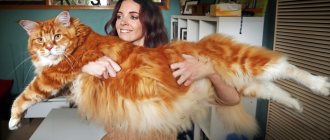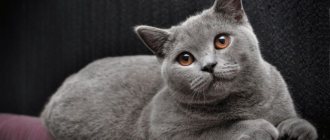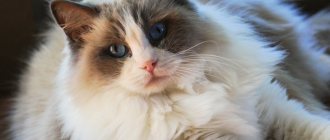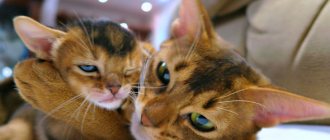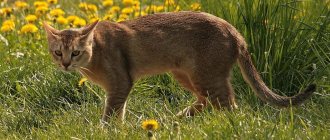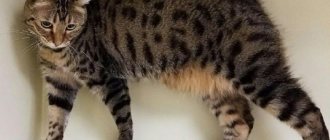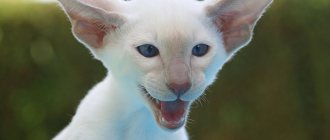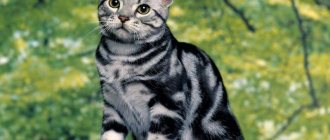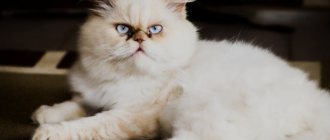All cat lovers have dreamed of petting a tiger at least once. Or a lion. Or a snow leopard. Well, or any other big cat that you just can’t pet - after all, each of them is a huge paradise on its paws! Fortunately, we have domestic cats, who are just as wonderful. Only small ones.
However, in nature there are compromise options. Today we want to show you the largest breeds of domestic cats from all over the world, which in size are as close as possible to real tigers and lions, only they (most likely) will also agree to live with you without biting off other people’s limbs for fun.
Top 10 biggest cats
Among the representatives of the largest breeds of domestic cats there are long-legged, lean, short-haired beauties and shaggy hulks with a somewhat predatory appearance.
The giants of domesticated representatives of the cat world, whose weight reaches fifteen kilograms or even more, include individuals of only a few breeds, and their prices are sometimes off the charts. Pets weighing from 7 to 12 kg are not so rare, but they look no less impressive and respectable. It is worth saying that cats, invariably included in the ranking of the largest, are mainly distinguished by their physique - solid bones, powerful muscles, and not at all by how well they are fed by their adoring owners. Without exception, all mustachioed giants reach their prime only by 3-4 years, and it is at this age that their individual weight is established. The overwhelming majority of males are much larger than females. Depending on the breed and litter, the difference in weight between them varies and can range from three to five to six kilograms.
Kurilian Bobtail
Average weight: male 5-7 kg, female 3-5 kg
They are excellent fishermen, although they do not like water. Representatives of this breed are very fond of active games, including chasing a toy and then returning it to its owner (don’t you think that the bigger the cat, the more doglike traits it has?). And look at the characteristic bobtail ponytail - it is surprisingly short (3-8 cm).
Savannah
Savannah, the largest domestic cat on the planet, is one of the rarest, most expensive, exotic and young breeds. Selection work on its breeding began in the 80s of the last century and took place in stages. In fact, the Savannah is a hybrid of a domestic cat and an African serval - a predatory mammal, a close relative of the lynx and caracal, but in its color this beauty is more reminiscent of a cheetah. Her homeland is the USA, or rather, one of the farms in the state of Pennsylvania, where, as a result of crossing a serval and a domestic Siamese cat, a female was born, who was named Savannah - it was she who became the ancestor of the new breed. Later, breeders included Bengal cats, Egyptian Mau, and Ocicats in the selection process. The breed standard was officially approved in 2001.
Savannah is a magnificent strong animal whose weight reaches 15 kg, and sometimes exceeds this figure. The length of the cat's body is about a meter, and the height at the withers is about half a meter. Distinctive features of her appearance are an elongated neck, a nobly set head, tall slender limbs, thick fur, and large ears.
Despite the fact that the Savannah has a wild and, one might even say, unkind look, it is not at all aggressive. This cat is quite sociable, friendly to children, devoted to its owner, understands commands perfectly, like a dog, and is ready to walk on a leash without whims. However, in urban conditions, the savannah experiences discomfort, as it needs an active lifestyle. She must be able to realize her instincts: climb to heights, hunt, jump, demonstrating the wonders of tightrope walking - from a standing position, this pet can easily “jump” 3.5 meters vertically. Savannahs are not at all afraid of water; on the contrary, they are not averse to swimming a fairly decent distance.
Not all savannahs are the same: their size and habits depend on the degree of kinship with their wild ancestor - the serval. The cats that are the least distant from the serval are those designated as an F1 hybrid. These are the heirs of the first generation of mating animals - wild and domestic. They are the largest, rarest and, accordingly, expensive. The higher the number after F, the less Serval blood the Savannah has. F7 hybrid animals, for example, are similar in build and size to a regular domestic cat. Savannah kittens can cost anywhere from $4,000 to $20,000.
In 2006, representatives announced the appearance of a new breed of cat - the Asher. These animals were the result of crossing a Bengal cat, an Asian leopard cat and a serval cat. Initially, the cost of a kitten in the nursery was 20 thousand dollars, but despite this, Ashera quickly gained popularity. It soon became clear, however, that the DNA of these felines is identical to that of the Savannah, so this breed is not recognized today as a separate breed. However, these exotic-looking cats remain in high demand, and their prices have dropped significantly.
Savannah (Asherah)
Attractions
Three kilometers from Bolshiye Koty there is a natural monument, Skriper Rock, an isolated mountain range composed of a rare rock on Lake Baikal - a Jurassic conglomerate, which is a sandy rock with rolled pebbles of various sizes. At an altitude of 200 meters on a rock there is a cave with two halls with an area of about 60 sq.m. Archaeologists in these caves discovered stone and iron hunting tools, fragments of pottery, including the bottom of a vessel with ancient Turkic signs.
Also in Bolshie Koty there is the Museum of Baikal Studies, the exhibition of which allows you to get the most complete picture of the flora and fauna of Lake Baikal.
Maine Coon
Second place in the list of the largest cats is occupied by Maine Coons. Giant cats of the Maine Coon breed became known in the middle of the 19th century, when they began to be shown at fairs held in the northeastern American state of Maine. Legends that Maine Coons appeared as a result of crossing domestic cats and wild animals, including raccoons and lynxes, are still popular. The Maine Coon supposedly inherited its distinctively colored tail from the raccoon, and its charming ear tufts from the lynx. These spectacular versions are beautiful, but from a genetic point of view they do not stand up to scrutiny. Dog handlers are confident that the breed formed independently, as a result of natural evolution, but is intraspecific.
Maine Coons reach maturity in their fourth year of life. At this age, their weight can be 12-15 kg. They have a large and long body, a powerful chest, well-developed muscles, thick, strong paws. In addition to their power, Maine Coons can also be proud of their luxurious thick coat. Another distinctive feature of the appearance of this animal is its incredibly fluffy tail, which the cat uses to wrap itself in the cold season.
Maine Coons have a wonderful character - soft and accommodating. They are intelligent, smart, friendly, but do not tolerate familiarity. These cats love to live in pairs. Male Maine Coons are excellent fathers, enthusiastically taking part in raising their offspring along with females.
The longest cat belongs to the Maine Coon breed. A male named Stu, a native of Nevada, is known for measuring 1.23 m from the tip of his nose to the tip of his tail.
Maine Coon
Appendix 2. Rest in the village of Bolshie Koty
If you want to relax on Lake Baikal, but don’t want to travel for a long time along a dusty road or on a train, don’t want to carry tents, sleeping bags and blankets and buy kilograms of food, then Big Cats is what you need. For example, on Thursday you wanted to go to Lake Baikal for the weekend. You thought about Listvyanka, Baikalsk, Maloe More, Olkhon. The last two are far and long to travel. The first two are already boring. What should I do? Go to the village of Big Cats!
Big Cats. Where is it?
Bolshie Koty is a small village on the shores of Lake Baikal, surrounded by mountains, 18 km north of Listvyanka. You can only get there by water. Or on foot, but that doesn't suit us.
On the river steamer "Voskhod" from the "Raketa" pier in Solnechny to your destination, it takes only 1.5 hours by water.
Where to live?
The best time to go to Bolshiye Koty is on Friday, and back on Sunday. On weekends, transport runs three times a day. By the way, if there are no tickets, the captain of the ship can always be persuaded to leave standing for the same money. And on the ship you can sit on the wide ledges between the two salons or on the bag.
There are many houses in the village in which rooms are rented for different numbers of people. The room has beds, bedside tables, chairs, a table, and a power outlet. Almost everywhere on the second floors there is a balcony overlooking Lake Baikal. There are hotels.
It is not necessary to bring food with you. There are kiosks and even mini-cafes in Koty. Almost every home sells hot smoked omul.
What kind of cats?
Nobody knows exactly what the name of the village means. Some might think that we are talking about the big cats that live here, but this is not so. There is an assumption that the village took its name from the river on which it was founded and on which prospectors panned for gold. Cats is a word of Evenki origin. Koto - literally "palm tree", "knife".
Some believe that the name of the river comes from the shoes of the cat (emphasis on the first syllable) - warm shoes usually used by gold miners in cold damp weather in swampy places.
Entertainment
There is not much entertainment in Bolshiye Koty. You can walk along the ecological trail of the Baikal National Park. The trail is easy to find. If you look at Baikal, it will be on the left, there are signs on the fences.
The path goes through the mountains. On one side there will be high mountains and rocks, on the other there will be a steep cliff and a lake. You can walk along the path for an infinitely long time.
In Bolshie Koty there is also the Museum of Baikal Studies and the aquarium of the Institute of Biology. The museum presents more than 400 different exhibits, a rich collection of insects: bugs, butterflies, dragonflies, lake animals, fish. Here are all the paintings painted by the founder of the museum, Professor M.M. Kozhov. The museum is already about 90 years old.
There is also a permanent research station on the basis of which Irkutsk students undergo summer internships.
If you can find a guide or guide, you can visit a multi-meter rock called Skriper. However, you can find it yourself if you follow the ecological trail. Here, on a steep slope, a cave was found with the remains of hunting tools and utensils from the Iron and Stone Ages.
There is a cave on Skriper: two small halls with an area of about 60 square meters, their length is 6 and 8 meters, width up to 3.5 and height up to 4 meters. In the cultural layer, archaeologists discovered stone and iron hunting tools and fragments of ornamented pottery.
Weather in Bolshiye Koty
From morning until 19.00, as a rule, it is hot sun and cloudless. After seven in the evening it gets cold and windy. At night there is most often rain and thunderstorms. In the morning the sun is back.
Irina Pokoeva. Irkipedia, 2006
Chausie
Large, stately and elegant Chausies are young cat breeds. They were developed in the USA in the 60s of the last century, and were registered only at the beginning of this century. The Chausie was created by crossing the Abyssinian domestic cat and the wild jungle cat, also known as the marsh lynx.
Chausies are athletically built, they have a long body, and the height at the withers can reach 40 cm, which puts them in third place in our ranking of the largest cats. The weight of an adult male reaches 14.5 kg. These amazing cats have a completely wild appearance. Their coloring, predatory look, and hunting habits make you wonder if you should be afraid of them. But upon closer acquaintance, it turns out that the chausie is the sweetest creature: affectionate, gentle, peaceful, loving to purr, and quite loudly.
From their predatory ancestors, these cats inherited a passion for hunting, a love of water and a desire to conquer heights. They love to stock up, often sneaking unattended food from the kitchen. They should be fed raw meat and fish, quail eggs; cereals are contraindicated for them.
Chausie is a very rare breed of cat because it is quite difficult to breed them. Chausies are most popular in their homeland - in the USA; there are several nurseries in Europe. In the post-Soviet space, chausie are considered a rarity. The cost of a kitten of this breed can reach $10,000.
Links
- History of Big Cats
- Photo of the village
- A unique chapel was consecrated in Bolshie Koty // SM Number One: newspaper.
- Weekend on Baikal // Friday: newspaper.
- Cats vote first // SM Number One: newspaper.
- Lake Baikal, village. Big Cats // website baikaler.ru
- Shouldn't we go to Big Cats? (5:11 min.) // RuTube
- A unique chapel was consecrated in Bolshie Koty // SM Number One: newspaper.
- Weekend on Baikal // Friday: newspaper.
- Cats vote first // SM Number One: newspaper.
- Lake Baikal, village. Big Cats // website baikaler.ru
- Shouldn't we go to Big Cats? (5:11 min.) // RuTube
Siberian and Neva masquerade cats
The Siberian cat is the pride of Russian breeders and the first domestic breed recognized by all international felinological organizations. The name of the breed, which began to be bred in the late 80s of the last century, is symbolic, since animals common throughout Russia, and not just Siberia, took part in the selection. The largest, strongest animals with heavy bones and thick, long hair were selected for breeding. The result turned out to be excellent: the Siberian cat looks like a real taiga inhabitant: hardy, powerful, big, harsh. The average weight of adult males is 10 kg, but 12-kg Siberians are not at all uncommon.
Siberian cats have a strong nervous system and high intelligence. They are calm, reasonable, patient with children, and attached to their owner like dogs. These cats are fearless and excellent hunters.
The Siberian cat rightfully takes fourth place in our ranking of big cats, and to it we will also add the Neva Masquerade cat, which is considered its subspecies. Breeders from the Kotofey club bred this magnificent breed under the guidance of felinologist Olga Mironova and presented it at her cat show in 1988. The Neva Masquerade cat owes its name to the Neva River, on which St. Petersburg stands, and the color of its face, similar to a carnival mask.
Today, breeding of Siberian cats is carried out in the USA, Canada, Great Britain, Germany, Spain, Italy, Finland and other countries. The number of nurseries located around the world is more than three hundred.
Siberian cat
Neva masquerade cat
Location
Bolshie Koty is located 20 km from the village of Listvyanka. The village, located in the taiga, is very popular among tourists who come here from all over the world. In summer, you can get to Bolshie Koty either by boat or on foot. There are no roads leading to the village. In winter, after Baikal freezes, a road is built along the ice along the shore. During the off-season, residents of Bolshiye Koty remain practically cut off from the world.
The biological station of Irkutsk State University operates here, and a monument to the famous Baikal expert prof. MM. Kozhov. There is regular communication by boat with Irkutsk and Listvyanka. The area is attractive with the Skriper cliff, a picturesque path along the shore of Lake Baikal, the Two Brothers rock, and abandoned gold mining sites. There is a hotel with 70 beds, a research base of the Limnological Institute of the SB RAS, which receives tourists in the summer (about 30 beds), about 50 tourists can be accommodated by local residents in private houses. 3 km from the village in the picturesque valley of the Cherny stream, 200 meters from Lake Baikal, there is a recreation center with 16 places.
Source: Baikal: nature and people: encyclopedic reference book / Baikal Institute of Nature Management SB RAS; [rep. ed. Corresponding member A.K. Tulokhonov] – Ulan-Ude: ECOS: Publishing house BSC SB RAS, 2009. – 608 pp.: color. ill.
Pos. Bolshie Koty is located 18 km north of the village. Listvyanka, in the summer, is connected by regular water trips from the m/v Voskhod with Listvyanka and Irkutsk. You can also get to the village from Listvyanka on ATVs or SUVs equipped with winches. In the village there is the Museum of Baikal Studies, founded by Professor M.M. Kozhov, and the aquarium of the Institute of Biology. The museum presents more than 400 different exhibits, a rich collection of insects: beetles, butterflies, dragonflies. There is also a permanent research station on the basis of which Irkutsk students do their internships. The small village is gradually becoming a holiday village.
Source: Volkov, S. On Baikal / Sergey Volkov. – M.: AST: AST Moscow, 2010. – 568 p.
Ragdoll and ragamuffin
The top five largest cats in the world are ragdolls, along with their charming subspecies - ragamuffins. Ragamuffin, which means “ragamuffin” in English, is the creation of the creative American breeder Anne Baker, also known as the founder of the Ragdoll breed. Actually, Ragamuffins are ragdolls crossed with mongrel cats. Their appearance is very reminiscent of ragdolls, but these delightful creatures have a richer palette of colors. Ragamuffins can be long-haired or short-haired.
Representatives of this breed have an elongated, strong, muscular body; by the age of four years, the age of full maturity, they can gain weight up to 10 kg. Ragamuffins are similar in character to ragdolls: they are just as gentle, affectionate, in need of the love and attention of their owner, and, despite their impressive size, completely defenseless against the aggression of other animals.
The breed was introduced in 1994, but numerous ill-wishers of Ann Baker for a long time prevented the official recognition of Ragamuffins. Only in 2003 these cats received a status separate from ragdolls and were recognized by international canine organizations.
Ragdoll
Well-fed Elvis
The cat's owners are currently trying their best to help him cope with excess weight. Elvis is given insulin injections twice a day and has also been prescribed a special diet to lose weight. They say that with the help of thoughtful nutrition, the gray and white cat got rid of 1 kilogram and continues to lose weight.
Now Elvis is considered “the fattest cat in Germany.” But according to the volunteers who took care of the animal’s health, this cat may receive the title of “the fattest cat in the world.” His weight, even after losing weight, remains greater than that of the cat, which is now recorded as “the fattest in the world” in the Guinness Book of Records.
Norwegian Forest Cat
Luxurious Norwegian forest cats are the pride of all of Scandinavia, where they are considered aboriginal animals. Presumably their ancient ancestors are long-haired representatives of the cat tribe brought to these harsh northern regions. As a result of natural selection and adaptation to the Scandinavian climate, they became the founders of a special population of cats - large, strong, distinguished by endurance and very thick hair. At the beginning of the last century, the Norwegian authorities provided official protection to native wild cats, obliging foresters and rangers in nature reserves to fight back against poachers who caught these beauties en masse and took them out of the country. In the 1930s, breeders began systematically breeding Norwegian forest cats to avoid extinction of the animals, while preserving their pristine beauty. The Norwegian Forest Cat breed was officially recognized only in 1977.
The Norwegian Forest Cat looks powerful yet elegant. It has a strong, elongated body, the hind limbs are noticeably longer than the front, which is more typical for a lynx than for a domestic cat. This proportion allows this animal to descend from a height head down in a spiral, like a squirrel, which is not typical for most pets. The weight of an adult male can reach 10 kg, but visually, thanks to his luxurious fur, he “pulls” a whole pound.
The Norwegian's character is as magnificent as his appearance. He is an excellent and loyal companion, very inquisitive, sociable, but not annoying. The cat is extremely friendly and is always ready to make friends with other pets.
In the second half of the last century, King Olav V of Norway gave the Norwegian Forest Cat the status of a national breed. In Western and Northern Europe, this charming animal has plenty of fans; in the USA they are not very popular, and in Russia there are only a few nurseries where you can buy a guaranteed purebred Norwegian Forest cat kitten. They operate in Moscow and St. Petersburg.
Norwegian Forest Cat
Literature
- Imetkhenov A.B. Natural monuments of Lake Baikal. — Novosibirsk: Science. Siberian branch, 1991. - 159 p.
- Evstropeva O.V., Ryashchenko S.V., Snytko V.A. Recreational zoning of the southern Baikal region // Geography and natural resources. 2000. - No. 1. - P. 6772.
- Catalog of recreational organizations, hotel-type enterprises. Irkutsk Regional Statistics Committee, 2000.
- Kotlyarov E.A. Geography of recreation and tourism. Formation and development of territorial recreational complexes. M.: Mysl, 1978. - 240 s.
- Kulakova T.Ya. Recreational assessment of natural complexes of the southwestern Baikal region (methodology, experience, practical research): Dis. .cand. geogr. Sci. Irkutsk, 1980. - 170 p.
- Lobanova T.A. Functional differentiation of recreational territories of the southern Baikal region // Geography and natural resources. 1987. - No. 4. - P. 164-167.
- Mikhailov Yu.P., Belov A.V., Ryashin V.Ya., Krotova V.M. Mapping of recreational resources in the south of Eastern Siberia // Estimated maps of nature, population, economy. M.: Moscow State University, 1973. - pp. 73-81.
- Motorin V.V. Climatic and recreational assessment of some areas of Siberia // Resort resources and sanatorium treatment in Siberia. -Tomsk, 1982.-S. 64-65.
British shorthair cat
The British Shorthair cat is one of the oldest and largest English breeds. The ancient ancestors of these animals are presumably cats, brought to Britain by Roman legionnaires before our era. Over the centuries, they have interbred not only with each other, but also with native wild cats. British Shorthair cats became known as a breed in 1871, when they were presented at the London Cat Show, after which they gained extreme popularity. However, at the beginning of the twentieth century, the fashion for these cats passed, and by the 50s their population had decreased significantly. To preserve the breed, breeders began crossing the few representatives of the British Shorthair with Persian cats, as a result of which today these cats look a little different than a century and a half ago.
The Briton is a large, but quite compact in his constitution strong man, who, thanks to his superbly sculpted muscles and unusual plush fur, looks even more powerful than he actually is. On average, adult cats weigh up to 9 kg, but some pets weigh up to 12 kg. This is usually due to the fact that representatives of this breed are prone to obesity because they become inactive as they age. By their nature, British Shorthair cats are calm and independent, they treat others selectively, and do not allow strangers to approach them at all.
There is an opinion that the illustrations for the book “Alice in Wonderland”, created by the English artist John Tenniel, depict a British shorthair cat. Today the Briton is the recognizable “face” of the Whiskas brand.
British shorthair cat
Scottish Fold (Scottish Fold)
Appearance. The Scottish Fold is distinguished by small triangular ears that are pressed to the skull. The animal is quite large, squat, powerful with a luxurious “fur coat” and thick undercoat.
The variety of colors is amazing: black, white, brown, tortoiseshell, marbled and others.
Character. A calm and balanced, kind and affectionate pet will become a true friend to its owner. Scottish Folds express their love by purring; they willingly climb onto their owner’s lap and come to bed.
Get along well with children and other pets. They love to play and have fun. They are calm about loneliness.
Care. The Scots' weak point is their eyes; they need to be checked daily for discharge.
These animals are prone to obesity; you will have to monitor their weight to avoid health problems. Otherwise, care is no different from caring for other cats.
Pixiebob
The breed, known today as the pixie bob, was originally formed through the process of cross-breeding in natural conditions between a domestic cat and a bobcat, a wild lynx. Due to the fact that these animals have the same karyotype, their offspring turned out to be fertile. In the 80s of the last century, American felinologists, having caught three wild individuals in the forest, began breeding them, trying to preserve the original appearance of the animal. In 1998, the new breed received the right to participate in the championships of the world's largest felinological organization TICA.
Externally, the pixie bob resembles a small lynx with a short tail. He has a powerful body, strong paws, and a wild, slightly gloomy look. The weight of an adult pet is 7-9 kg. Despite its stern and menacing appearance, the pixie-bob is a fairly peaceful, calm creature. It is not aggressive, rarely releases its claws, and will not bite a person at full strength. These cats are similar to dogs in their behavior and devotion. Pixiebobs do not meow, but when they play with each other, they growl. Their purring is not like the songs of domestic cats - it is very loud and heavy. These animals do not welcome other pets, but they also do not enter into conflicts with their four-legged brethren - they simply maintain their distance.
Pixie bobs produce few offspring - there are usually 2-3 kittens in a litter. This rare breed is recognized as a national treasure of the United States. Official permission is required to take cats out of the country.
Pixiebob
Content Features
Large domestic cats are gaining more and more fans due to their unpretentiousness.
The most difficult part of keeping cats of these breeds may be the area of a residential building in which small, large-sized domestic predators will live. Most big cats carry the genes of wild animals that require large hunting areas. Active, agile, playful, large cats require frequent walks in the fresh air, where they can splash out excess energy and satisfy their hunting instincts.
The diet for such representatives of the purr must be complete and balanced so that the high weight required by breed standards does not become obese. It is best to feed cats natural food, which includes different types of meat, seafood, eggs, cereals, vegetables and dairy products; you also need to add vitamins. But you can also use high-quality dry food, occasionally supplementing with canned food. Food should be selected based on the breed of the cat and the length of its fur. For cats with thick undercoat, medications are needed to prevent the formation of hairballs in the stomach.
Best articles: Brief characteristics of the terrestrial planets in the Solar System
Caring for animals involves combing their fur coat. If the cat lives in an apartment, you can sometimes wash it and trim its claws. But more often than not, these cats are able to take care of themselves on their own, keeping themselves clean, especially those living in an enclosure.
You can learn how to make a cat happy by watching the video below.
Turkish van
The ancestors of the Turkish Van are aboriginal semi-long-haired cats, who from time immemorial lived in the area adjacent to Lake Van, located in Turkey. This breed was discovered in the modern world by British journalist Laura Lushington, a big cat lover. From her trips to this region of Turkey in the 50s of the last century, she several times brought charming kittens, with which the breeding of the Turkish Van cat breed in Europe began. Today, the Turkish Van is recognized by all leading felinological international organizations.
An adult Turkish Van cat can weigh up to 9 kg. His body is muscular, long, with a wide, powerful chest. These pets love water fun and swim well. They are very active, sociable, overly inquisitive and emotional. They have a well-developed hunting instinct. In childhood and adolescence, these cats can even show some aggressiveness, biting and scratching their owners. However, with age their character becomes softer.
In Turkey, aboriginal Van cats (they are called van kedisi here) are very revered, are one of the symbols of the country and are listed in the Red Book. They are credited with the gift of bringing happiness and good luck; these animals are even allowed to enter the mosque. It is possible to export Turkish Vans from the country only with official permission.
Turkish van
Interesting Facts
The biggest cats also include the fattest. According to the Guinness Book of Records, today this title is awarded to the cat SpongeBob, who weighs 15 kg. The pet is currently on a diet. And in general, the founders of the book decided to remove this category from great achievements, so that cat owners would not try to become famous at the expense of the health of their pets.
Throughout the history of records, the prize has been awarded several times, and according to its statistics, the fattest was an Australian cat named Khimiya, whose weight was more than 21 kg. The poor guy died from obesity and related diseases.
Having the biggest cat in your personal possession is not the greatest achievement. Yes, size matters, but love for your pet should come first.
Let's watch a video from the Nat Geo channel about another of the biggest and fattest cats in the world, named Meow:
Chartreuse
The Chartreuse, or Carthusian, as well as medieval cat, is considered a French breed. However, historians in the field of felinology are confident that the ancestors of the Chartreux are cats brought to France from the East during the Crusades. In the 16th century, they were described as stocky animals with an ash-gray color with a blue tint. Initially, these big cats lived at the main monastery of the Carthusian order of Grand Chartreuse, but over time they bred in other regions of the country. After the First World War, French breeders began systematic breeding of the breed, and in 1928, Chartreuse was already taking part in exhibitions. Today, nurseries for breeding Chartreuse are located mainly in France and the USA.
In their appearance, Chartreuse cats resemble British shorthair cats, but they have a different constitution and lack the pronounced plushness of the coat characteristic of the British. When looking at their dense, well-built, compact body and short limbs, it may seem that these pets are lightweight, however, when you pick up a Chartreuse in your arms, you will immediately understand how deceptive this impression is. Adult Chartreux have significant muscle mass and can weigh up to 7 kg. They are very balanced and measured, one might even say phlegmatic. They seem to enjoy observing rather than acting. Chartreux meows very rarely, and their voice is so quiet that it is like a whisper.
It is difficult to find purebred Chartreuse in Russia. Often, even in nurseries under the name “chartreuse” they sell shorthaired blue cats of the British breed, European shorthaired blue cats or hybrids of these breeds. You can purchase a guaranteed purebred kitten in clubs that are members of the international felinological organization FIFe.
Chartreuse
Irbis - snowy beauty
An unusually beautiful leopard with smoky gray fur with black spots. The snow leopard lives high in the mountains and occasionally descends to the foot, following the migration of ungulate herbivores. In appearance, this strong cat resembles a leopard, but is squat and smaller. The body of the snow leopard is stretched, slightly raised in the sacrum area. The height of the withers is no more than 60 cm, and the body length ranges from 103 to 130 cm. The main habitat of the snow leopard is South and Central Asia.
They feed, train and raise their young, and the female mercilessly plucks fur from her belly to insulate her den.
Currently, there are no more than 7 thousand snow leopards worldwide. Unfortunately, snow leopards practically do not reproduce in captivity, so the population of these magnificent animals continues to decline. It is almost impossible to meet this rare endangered species in the wild; the snow leopard carefully avoids people.
Lil Bub
One of the most famous cats in the world. Lil Bub became famous thanks to the Internet and her unusual appearance. Osteoporosis and genetic mutations are to blame. She had difficulty walking, and her appearance often became the object of increased attention. Lil Bub had an unusual muzzle structure; she had no teeth, which is why her tongue was constantly sticking out. This cat did not live a very long life (2011 – 2019), but it was a happy one. Her owner, Mike Bridavsky, loved his pet very much. He used the cat's characteristics for good purposes.
Throughout her life, Lil collected about 700 thousand dollars, all of which were donated to the fund to fight rare animal diseases. Lil Bub starred in the film and became a real star. Her Instagram account has about 2.5 million followers.
Chausi, 6–12 kg
Chausie is included in the list of the most exotic and expensive breeds. A miniature copy of a wild cat can become a worthy companion and will fall into the soul of even the most avid dog lover.
Chausi miraculously combine sociability and independence, which additionally gives them charm. Unlike most cats, representatives of this interesting breed love water, so you shouldn’t be surprised if the cat willingly creates splashes in the bathroom - it makes her happy!
Chausie is an extravagant cat that is highly trainable due to its desire to learn something new and its developed intelligence.
